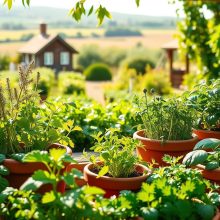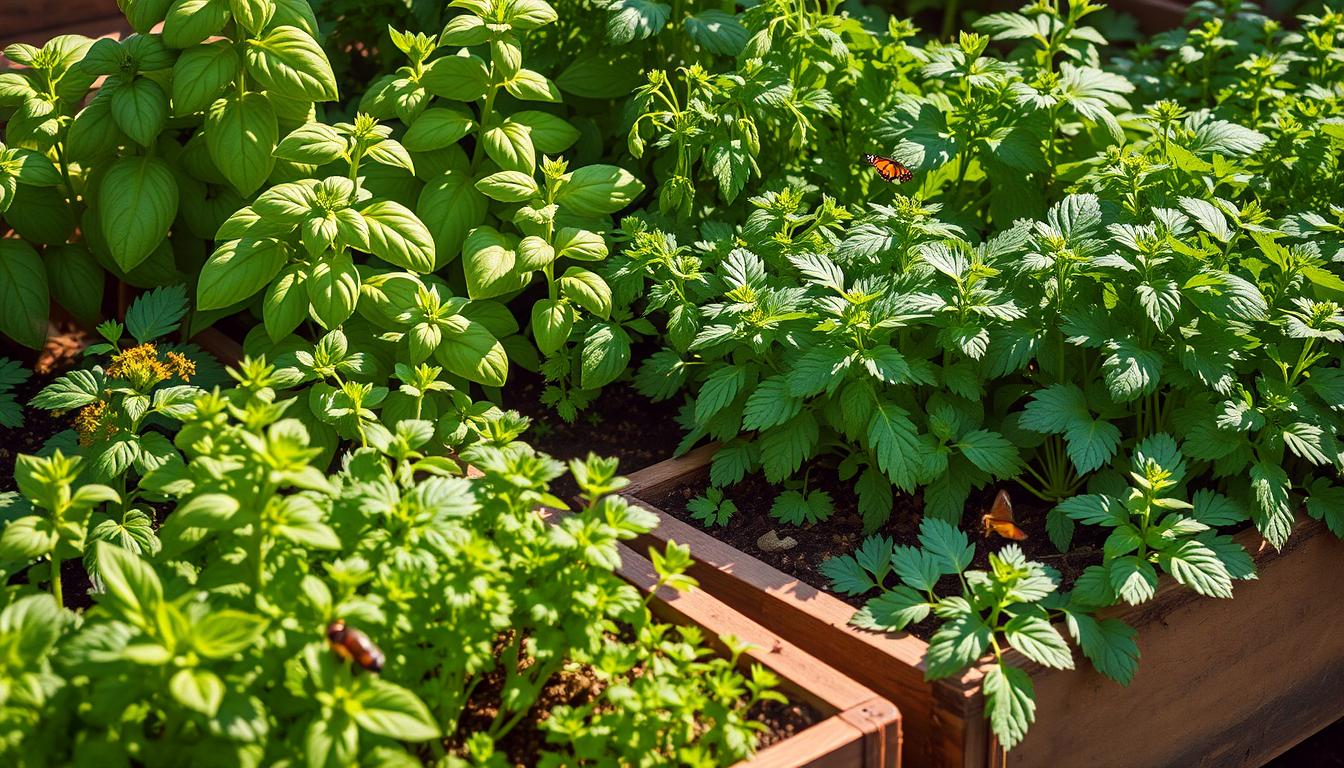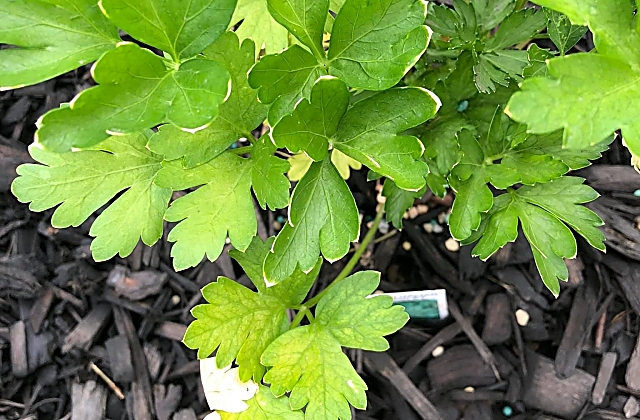Herb Garden Maintenance: Easy Steps for a Lush Plot
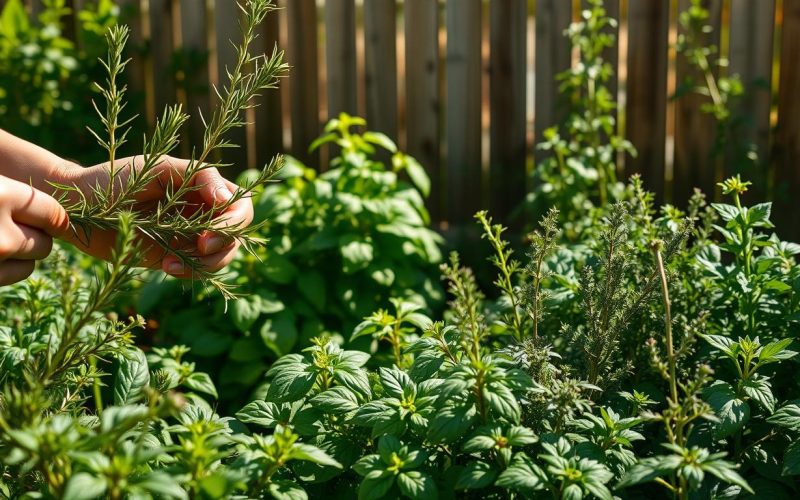
Growing a thriving herb garden is easy. With the right techniques, anyone can have a vibrant and productive garden. This garden will give you fresh, flavorful ingredients right at home.
Herb gardens are more than just a place to grow food. They help you save money on groceries and offer a fun hobby. Whether you’re new to gardening or have experience, learning how to care for your herbs can make your garden lush and healthy.
Key Takeaways
- Herb gardens provide fresh, organic ingredients
- Proper maintenance ensures healthy plant growth
- Sustainable gardening reduces food costs
- Anyone can learn effective herb garden techniques
- Gardens create a connection with natural environments
Understanding the Basics of Herb Gardening
Herb gardening is a fun mix of cooking, nature, and health. It’s great for both new and seasoned gardeners. Learning the basics of herb garden care can turn your space into a lush paradise.
Herbs are more than just cooking ingredients. They add fresh taste, health benefits, and beauty to any spot.
Benefits of Growing Herbs
- Fresh culinary ingredients at your fingertips
- Natural health and wellness support
- Cost-effective alternative to store-bought herbs
- Attractive landscaping element
- Stress-reducing gardening activity
Selecting the Right Location
Choosing the right spot is key to a good herb garden. Most herbs need about six hours of sun a day. Some, like parsley and chives, can handle a bit of shade, making them versatile.
Choosing the Right Containers or Garden Space
Good herb garden care starts with the right growing spot. Think about these things when planning your garden:
- Sunlight exposure
- Soil drainage
- Container size
- Herb variety requirements
- Available garden space
By knowing these basics, you’ll have a thriving herb garden. It will give you fresh ingredients and beauty all season long.
Essential Tools for Herb Garden Maintenance
To have a thriving herb garden, you need the right tools. A good herb garden maintenance checklist starts with knowing which tools are best. Whether you’re new or experienced, the right tools make gardening fun and easy.
Choosing quality tools is key to easy gardening. They make your tasks simpler and more efficient.
Must-Have Gardening Tools
- Pruning Shears: Essential for trimming and shaping herb plants
- Hand Trowel: Perfect for planting and transplanting herbs
- Watering Can: Allows precise water distribution for delicate herbs
- Gardening Gloves: Protects hands during maintenance tasks
- Garden Scissors: Ideal for harvesting and delicate cutting
Optional Tools for Advanced Gardeners
- Soil pH Tester: Helps monitor nutrient levels and soil conditions
- Mini Greenhouse: Supports seed starting and seedling protection
- Moisture Meter: Ensures accurate watering for sensitive herbs
- Pruning Saw: Manages larger herbs and woody stems
- Garden Cart: Helps transport tools and plants with ease
Getting these tools will greatly improve your herb garden care. It will help you grow a lush and productive garden with less effort.
Soil Requirements for Healthy Herbs
Creating the perfect soil environment is key in your herb garden maintenance guide. Healthy herbs need the right soil and nutrients for growth. The right soil is the foundation of a thriving herb garden.
Herb cultivation depends on soil characteristics that support plant health. Understanding these requirements is the first step in maintaining an herb garden.
Key Nutrients for Herbs
Herbs need a balanced mix of nutrients to grow well. The most important nutrients are:
- Nitrogen: Supports leafy green growth
- Phosphorus: Encourages root development
- Potassium: Enhances overall plant health
- Calcium: Strengthens cell walls
- Magnesium: Vital for chlorophyll production
Soil pH and Drainage Considerations
Most herbs prefer slightly acidic to neutral soil with a pH between 6.0 and 7.0. Good drainage is also crucial. Mediterranean herbs like rosemary and thyme do well in sandy, well-draining soil.
- Test soil pH using home testing kits
- Add organic matter to improve drainage
- Avoid heavy clay soils that retain excess moisture
- Consider raised beds for better soil control
By focusing on these soil fundamentals, gardeners can create an optimal growing environment. This supports healthy, vibrant herbs all season long.
Watering Your Herb Garden Effectively
Water is key for a healthy herb garden. Finding the right balance is crucial. It keeps plants thriving without harm. Learning how to water correctly can make your garden flourish.

Best Practices for Watering Herbs
Smart watering is the first step in caring for your herbs. Each herb needs a specific amount of water. Here are some basic tips to keep your herbs looking their best:
- Water deeply but infrequently to encourage strong root development
- Check soil moisture before watering by inserting your finger into the soil
- Use a watering can with a gentle spout to avoid damaging delicate plants
- Water early in the morning to reduce evaporation and fungal growth
Recognizing Signs of Over- or Under-Watering
Knowing when your plants need water is part of garden care. Look for these signs to adjust your watering:
- Under-watered herbs show:
- Wilting leaves
- Dry, crispy edges
- Slow growth
- Over-watered herbs display:
- Yellowing leaves
- Soft, mushy stems
- Potential root rot
By following these tips, you’ll have a vibrant herb garden. It will offer fresh flavors and fragrances all season long.
Fertilization Techniques for Herby Goodness
Keeping your herb garden healthy means knowing what nutrients your plants need. Most herbs do well in soil that’s not too rich. This means they don’t need a lot of fertilizer. It’s important to manage nutrients well to keep your herbs happy.
Choosing the right way to feed your herbs is crucial. It can greatly improve their health and how well they grow. Let’s look at the best ways to feed your herbs.
Organic vs. Synthetic Fertilizers
There are two main types of fertilizers for herb gardens:
- Organic Fertilizers
- Compost
- Worm castings
- Aged manure
- Synthetic Fertilizers
- Chemical nutrient blends
- Balanced NPK formulas
- Granular or liquid options
Timing and Frequency of Fertilization
Fertilizing your herbs at the right time is key. Most herbs don’t need a lot of food, only when they’re actively growing. Here are some tips for keeping your herbs healthy:
- Apply organic compost in early spring
- Use light, balanced fertilizers during growing season
- Avoid over-fertilizing, which can reduce herb flavor
- Stop fertilizing 4-6 weeks before expected first frost
Every herb is different and may need different nutrients. Watch how your plants respond to fertilizers. Adjusting your feeding schedule can help your herb garden stay vibrant and flavorful.
Pruning and Harvesting Herbs
Learning to prune and harvest herbs is key to a successful garden. The right methods keep plants healthy and boost your harvest. Knowing when and how to prune each herb can make gardening more rewarding.
Regular pruning makes herbs bushier and more productive. While each herb needs its own care, some rules apply to all. These help you keep your herb garden thriving.
Pruning Techniques for Healthy Herbs
- Use sharp, clean pruning shears to prevent plant damage
- Cut just above leaf intersections to promote branching
- Remove dead or yellowing leaves regularly
- Prune before plants flower to maintain leaf production
Best Harvesting Practices
- Harvest herbs in the morning after dew has dried
- Cut no more than 1/3 of the plant at a time
- Pinch off leaves from the top to encourage fuller growth
- Avoid harvesting during extreme heat or cold
Each herb has its own best time to harvest. Basil does well with regular pruning, while rosemary needs a gentler touch. Make sure your garden care plan includes specific tips for each herb to keep them healthy and productive.
Pest Control in Your Herb Garden
Keeping your herb garden pest-free is key to its health. Pests can harm your herbs, making them less healthy and productive. Knowing which pests to watch out for and how to control them is crucial for a thriving garden.
Identifying Common Garden Pests
Herb gardens often face problems from pests. Some common pests include:
- Aphids – tiny insects that suck plant sap
- Spider mites – microscopic pests that create web-like structures
- Whiteflies – small flying insects that cluster under leaves
- Caterpillars – larvae that chew through herb leaves
Organic Pest Control Solutions
Using natural methods to fight pests is important. Organic pest control keeps your garden safe from harmful chemicals.
- Introduce beneficial insects like ladybugs and lacewings
- Spray neem oil to disrupt pest reproduction cycles
- Use insecticidal soap for soft-bodied insects
- Create physical barriers with row covers
By following these tips, you can keep pests away and keep your herbs healthy and vibrant.
Managing Weeds in Your Herb Plot
Weed management is key to a successful herb garden. It’s about keeping your garden free from unwanted plants. This requires strategy and consistent effort. Understanding how weeds compete with your herbs is important.
Preventing weeds is the first step. Smart gardening techniques can help. This way, you protect your herbs from weeds.
Preventing Weed Growth
- Use organic mulch to block weed seeds from germinating
- Maintain proper plant spacing to reduce weed-friendly areas
- Use landscape fabric as a barrier in garden beds
- Keep garden areas clean and free of plant debris
Effective Weeding Techniques
- Hand-pull weeds when soil is slightly moist
- Use specialized weeding tools for root removal
- Remove weeds before they go to seed
- Apply targeted spot treatments with organic herbicides
Staying proactive about weed control is crucial. Regular checks and quick removal keep your garden healthy. This way, your herb garden stays productive.
Seasonal Care for Herb Gardens
Keeping your herb garden healthy all year needs a smart plan. Each season brings its own needs for your herbs. Knowing what your herbs need at different times helps your garden grow well and gives you fresh herbs for cooking.
Adapting your gardening to the seasons is key. Each season has its own challenges and chances to help your herbs grow.
Spring Preparation Tips
- Clean garden beds and remove winter debris
- Test and amend soil with organic compost
- Start seeds indoors for heat-sensitive herbs
- Prune perennial herbs to encourage new growth
Summer Maintenance Strategies
- Water herbs deeply and consistently
- Mulch around plants to retain moisture
- Harvest herbs regularly to prevent flowering
- Monitor for pest activity and use organic control methods
Fall Harvesting Tips
- Collect seeds from annual herbs
- Dry and preserve herb harvests
- Prepare perennial herbs for winter dormancy
- Consider bringing tender herbs indoors
Following these seasonal tips helps your herb garden stay strong and productive all year.
Companions and Interplanting
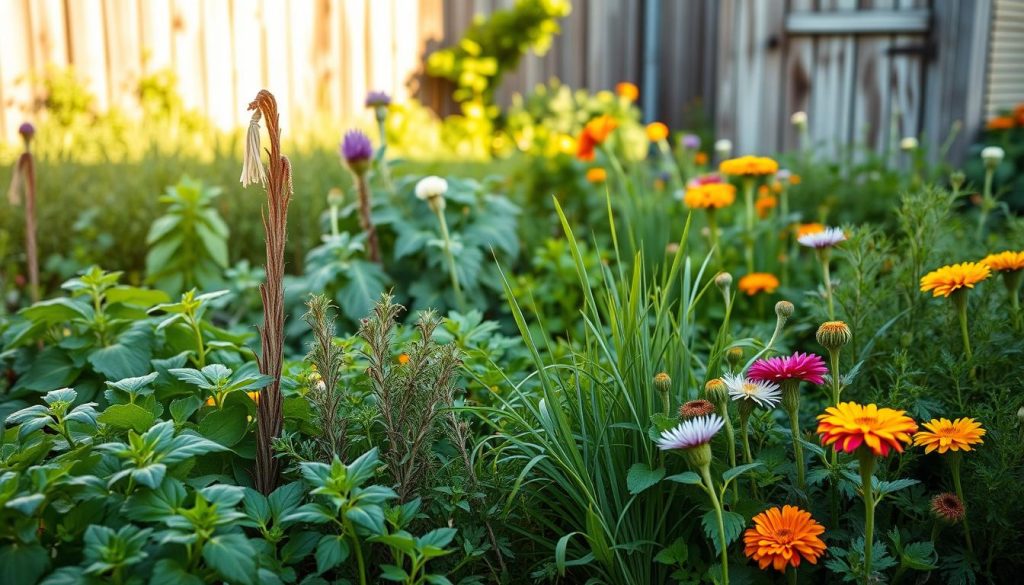
Companion planting is a key strategy in herb garden care. It can make your garden healthier and more productive. By placing plants together wisely, gardeners can build a strong ecosystem. This ecosystem supports healthy herb growth and fights pests naturally.
Benefits of Companion Planting
Learning about companion planting is essential for herb garden care. This method brings many benefits:
- Natural pest control
- Enhanced plant growth
- Improved flavor profiles
- Efficient use of garden space
Ideal Plant Combinations for Your Herb Garden
Choosing the right plant companions is important for herb garden care. Some great pairings are:
- Basil with tomatoes: Repels insects and enhances tomato flavor
- Rosemary near carrots: Deters carrot flies
- Sage with cabbage: Helps protect against harmful insects
- Chamomile with onions: Improves overall plant health
Using these companion planting strategies helps gardeners grow a stronger, more productive herb garden. This garden needs less care and gives better results.
Propagating Herbs: A Step-by-Step Guide
Expanding your herb garden doesn’t have to cost a lot. With the right steps, you can grow more herbs easily. Learning to propagate herbs is key for any gardener wanting to improve their garden care.
Herb propagation has two main ways: growing from seeds and taking cuttings. Each method works best for different herbs in your garden.
Seed Propagation Strategies
- Select high-quality seeds from reputable gardening suppliers
- Use sterile seed-starting mix for optimal germination
- Maintain consistent moisture and temperature
- Provide adequate light for seedling development
Cutting Propagation Techniques
- Choose healthy parent plants with robust growth
- Cut 4-6 inch stems just below a leaf node
- Remove lower leaves to prevent moisture loss
- Place cuttings in rooting hormone
- Maintain humid environment for root development
Herbs like rosemary, mint, and sage root well from cuttings. Parsley and cilantro do best from seeds. By learning these methods, gardeners can grow more herbs and garden sustainably.
Indoor vs. Outdoor Herb Gardening
Keeping an herb garden indoors or outdoors has its own set of rules. Each method has its own perks and downsides for those who want fresh herbs all year.
When growing herbs, you must think about the environment. Indoor gardens offer a safe space from bad weather and pests. They let you grow herbs all year, no matter the season.
Benefits of Indoor Herb Gardens
- Consistent temperature and humidity control
- Protection from pests and extreme weather
- Easy access to fresh herbs while cooking
- Minimal herb garden upkeep requirements
Outdoor gardens, on the other hand, let herbs grow in nature. They need more care but can grow stronger.
Special Considerations for Outdoor Herbs
- Select herbs tolerant to local climate conditions
- Implement proper drainage systems
- Protect plants from unexpected frost
- Monitor sunlight exposure carefully
Both indoor and outdoor gardens can do well with the right care. Think about your space, climate, and what you want to grow before deciding.
Common Herb Gardening Mistakes to Avoid
Keeping an herb garden healthy needs careful attention. Many gardeners make mistakes that harm their garden. Knowing these mistakes helps you keep your garden in top shape.
When starting with herb garden care, gardeners face many challenges. These can slow down plant growth and affect the garden’s health.
Plant Spacing and Overcrowding
Putting too many plants in a small space is a big mistake. Herbs need room to grow well. Too many plants in a small area can cause problems:
- Less air gets around the plants
- Diseases spread easier
- Plants fight for food
- They grow slower
Understanding Light Requirements
Not knowing what light each herb needs is another mistake. Herbs need different amounts of sunlight. Some love full sun, while others prefer shade. Placing them right helps them grow and taste better.
- Mediterranean herbs like rosemary and thyme need full sun
- Mint and parsley do well in partial shade
- Always check the light needs for each herb
Avoiding these mistakes helps create a vibrant herb garden. It will give you fresh, tasty herbs all season long.
Conclusion: Enjoying Your Herb Garden
Mastering your herb garden maintenance guide brings joy and flavor to your cooking. It’s more than growing plants; it’s creating a living pantry. This pantry changes how you cook and take care of yourself.
Fresh herbs are great for more than just cooking. They can make homemade teas and beauty products. By drying or freezing herbs, you keep flavor and nutrition all year. The care tips you’ve learned will help you enjoy more from your garden.
Sharing Your Garden’s Gifts
Sharing your harvest is one of the best parts of herb gardening. Giving fresh herbs to friends and family spreads happiness. You can also make small gift packages or host a garden-to-table event.
Your herb garden shows your patience, care, and love for nature. Enjoy the journey, try new herbs, and keep learning. Each season offers new chances to improve and learn more about herbs.
